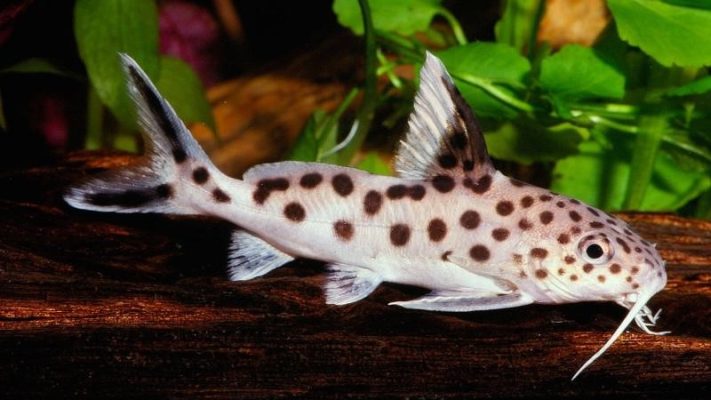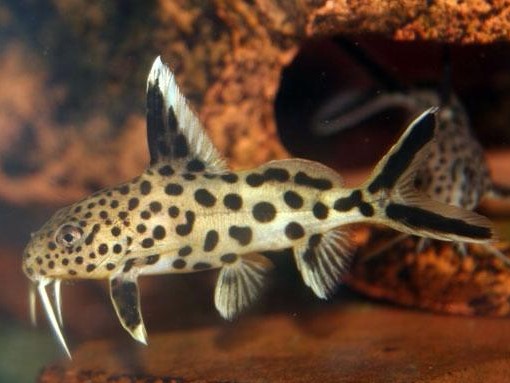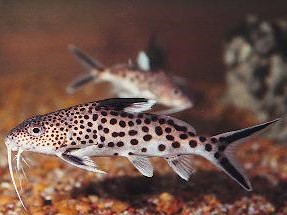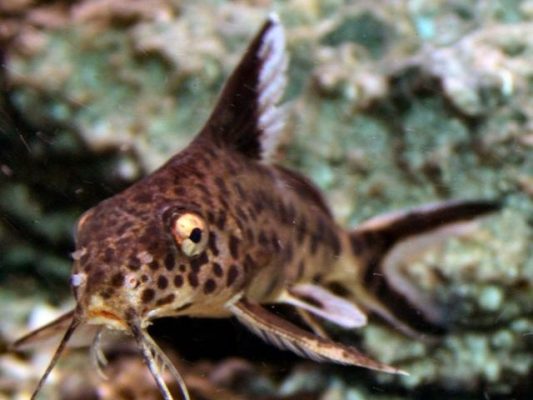Cuckoo Squeaker

Table of Contents
- Introduction
- Taxonomy and Classification
- Physical Characteristics
- Habitat and Distribution
- Behavior and Reproduction
- Conclusion
Introduction
The Cuckoo Squeaker (Synodontis multipunctatus) is a captivating species that has gained significant popularity among aquarists in the aquarium hobby. Its unique characteristics and intriguing behavior make it stand out among other fish species. However, replicating its native habitat in an aquarium setting poses several challenges.
Aquarists are drawn to the Cuckoo Squeaker due to its striking appearance and fascinating behavior. This species is known for its elongated body, adorned with a beautiful pattern of spots and markings. Its distinctive appearance adds an aesthetic appeal to any aquarium.
Furthermore, the Cuckoo Squeaker is an active and social fish, often engaging in interesting interactions with other tank mates. It displays a complex range of behaviors, including territorial defense, courtship rituals, and mouthbrooding, which captivate the attention of aquarium enthusiasts.
Studying the Cuckoo Squeaker is of great significance in terms of understanding its behavior, ecology, and conservation implications. By delving into the intricacies of this species, scientists can gain valuable insights into the functioning of aquatic ecosystems and the management of aquaculture and fisheries.
The behavior of the Cuckoo Squeaker provides a window into the social dynamics and hierarchy within the species. Observing its interactions with conspecifics and other fish species can shed light on the complexities of fish behavior and social structures. By studying these behaviors, researchers can expand our understanding of fish communication, dominance hierarchies, and territoriality.
Furthermore, the Cuckoo Squeaker plays an important ecological role in maintaining the balance of aquatic ecosystems. Its feeding habits and diet preferences influence the abundance and distribution of prey species, thereby impacting trophic dynamics. By studying the Cuckoo Squeaker’s ecological interactions, scientists can gain insights into the intricate web of relationships within aquatic food chains.
In addition, the Cuckoo Squeaker holds potential for aquaculture and fisheries management. Understanding its reproductive strategies, such as brood parasitism and mouthbrooding, can contribute to the development of improved breeding techniques for other fish species. Furthermore, insights gained from studying the Cuckoo Squeaker’s habitat preferences and adaptations can aid in the conservation and management of fish populations in natural ecosystems.
Overall, the Cuckoo Squeaker serves as a fascinating subject for scientific research, offering valuable knowledge that extends beyond its own species. By studying this unique fish, scientists can deepen our understanding of fish behavior, ecology, and evolution, while also contributing to the conservation and sustainable management of aquatic ecosystems.
Taxonomy and Classification
Description of the Cuckoo Squeaker’s Taxonomic Classification
The Cuckoo Squeaker, scientifically known as Synodontis multipunctatus, belongs to the family Mochokidae, commonly referred to as the squeaker catfish family. Within this family, it is classified under the genus Synodontis. The species name multipunctatus is derived from the Latin words “multi” meaning many and “punctatus” meaning spots, referring to the numerous spots that adorn its body.
The Cuckoo Squeaker shares its family with various other species of catfish, including the upside-down catfish (Synodontis nigriventris) and the featherfin squeaker (Synodontis eupterus). These species are known for their unique adaptations and behaviors, making them popular among aquarium enthusiasts.
Explanation of its Scientific Name and its Meaning
The scientific name Synodontis multipunctatus holds significant meaning that reflects the physical characteristics and behavior of this fascinating species. The term “Synodontis” is derived from the Greek words “syn” meaning together and “odontis” meaning teeth, referring to the closely spaced teeth found in the species’ mouth. This adaptation allows the Cuckoo Squeaker to efficiently capture and consume its prey.
The species name “multipunctatus” refers to the multitude of spots that adorn the body of the Cuckoo Squeaker. These spots vary in size and shape, creating a unique pattern that distinguishes this species from others in its genus. The spots serve as a form of camouflage, helping the fish blend into its natural environment and evade potential predators.
The etymology of the scientific name also provides insight into the cultural and historical references associated with the Cuckoo Squeaker. The word “cuckoo” is derived from the sound of the bird’s call, which resembles the sound produced by the Cuckoo Squeaker when it is disturbed or threatened. This unique vocalization adds to the species’ allure and makes it a sought-after addition to aquariums.
In conclusion, the taxonomic classification and scientific name of the Cuckoo Squeaker, Synodontis multipunctatus, highlight its close relationship to other catfish species within the Mochokidae family. The scientific name further emphasizes the species’ distinctive physical characteristics, such as its closely spaced teeth and the multitude of spots on its body. Understanding the taxonomy and scientific name of the Cuckoo Squeaker enhances our appreciation for its unique traits and contributes to our broader knowledge of fish diversity.
Physical Characteristics
Size and Shape of the Cuckoo Squeaker
The Cuckoo Squeaker, scientifically known as Synodontis multipunctatus, exhibits a range of sizes depending on its age and gender. On average, adult Cuckoo Squeakers measure between 4 to 6 inches in length, with males being slightly larger than females. However, it is important to note that some individuals can grow up to 8 inches in length, making them one of the larger species within the Synodontis genus.
In terms of body shape and structure, the Cuckoo Squeaker possesses a streamlined and elongated body, which is typical of catfish species. This body shape allows them to navigate through the dense vegetation and rocky crevices of their natural habitat with ease. Additionally, their body is covered in a layer of protective slime, which aids in reducing friction as they move through the water.
Coloration and Patterns on Its Body
The coloration of the Cuckoo Squeaker is a captivating aspect of its physical appearance. The base color of its body is typically a pale to medium brown, providing effective camouflage in its natural habitat. This coloration allows the Cuckoo Squeaker to blend in with the sandy or rocky substrate found in the African lakes where it originates.
What truly sets the Cuckoo Squeaker apart is its intricate pattern of dark spots covering its body. These spots vary in size and density, creating a visually striking mosaic. The spots are most prominent on the dorsal and lateral sides of the fish, while the ventral side tends to have fewer spots or even none at all. This unique spotted pattern is not only aesthetically pleasing but also serves as a form of disruptive coloration, helping the Cuckoo Squeaker to break up its body outline and further enhance its camouflage.
Unique Features and Adaptations
The Cuckoo Squeaker possesses several distinctive features and adaptations that contribute to its survival in its natural habitat. One notable feature is its specialized mouth structure. The Cuckoo Squeaker has a downward-facing mouth with fleshy, sensitive barbels, which are elongated sensory organs. These barbels help the fish locate food in the dark and murky waters of its environment. They are particularly useful for detecting prey items such as small invertebrates and insect larvae that are hidden within crevices or buried in the substrate.
Another remarkable adaptation of the Cuckoo Squeaker is its ability to produce audible sounds. It has been observed that this species can produce a series of squeaking or grunting sounds by rubbing its pectoral spines against the pectoral girdle. These sounds are believed to serve various purposes, including communication with conspecifics, territorial defense, and courtship displays.
Furthermore, the Cuckoo Squeaker possesses a well-developed swim bladder, which aids in buoyancy control. This internal gas-filled organ allows the fish to adjust its position within the water column, enabling it to navigate through different depths and habitats with ease.
Overall, the combination of its streamlined body shape, effective camouflage, specialized mouth structure, and unique sound-producing abilities make the Cuckoo Squeaker a fascinating and well-adapted species within the aquarium hobby.
Habitat and Distribution
Overview of the natural habitat of the Cuckoo squeaker
The Cuckoo Squeaker, also known as Synodontis multipunctatus, is native to the freshwater habitats of Lake Tanganyika in East Africa. This lake is one of the largest and deepest lakes in the world, renowned for its rich biodiversity and unique ecosystem. The Cuckoo Squeaker primarily inhabits the rocky areas and sandy substrates of the lake, seeking refuge and finding suitable food sources.
Lake Tanganyika is characterized by its clear, oxygen-rich waters, which are crucial for the survival of the Cuckoo Squeaker. The lake’s water parameters, including temperature, pH, and mineral content, play a significant role in shaping the species’ habitat preferences. The Cuckoo Squeaker thrives in water temperatures ranging from 24 to 27 degrees Celsius and prefers slightly alkaline to neutral pH levels.
The rocky areas provide ample hiding spots for the Cuckoo Squeaker, allowing it to evade predators and establish territories. These rocky habitats also offer a diverse range of microorganisms and invertebrates, which serve as important food sources for the species. The Cuckoo Squeaker is known to be a bottom-dwelling fish, often exploring crevices and caves in search of prey.
Geographical distribution and range
The Cuckoo Squeaker is endemic to Lake Tanganyika and its surrounding tributaries. Within the lake, it can be found along the eastern shoreline, particularly in the southern and central regions. Its distribution extends from the northern part of the lake, near Burundi, to the southernmost tip, reaching Tanzania.
The species’ range is influenced by various factors, including water temperature, depth, and the availability of suitable habitats. It tends to inhabit the rocky areas with sandy substrates, where it can find shelter and access its preferred food sources. The Cuckoo Squeaker is known to occupy different depths within the lake, ranging from shallow areas close to the shoreline to deeper regions up to 100 meters.
Factors influencing its habitat selection
The Cuckoo Squeaker’s choice of habitat is influenced by several factors that contribute to its survival and reproductive success. One crucial factor is food availability. The rocky areas of Lake Tanganyika provide a diverse range of microorganisms, small invertebrates, and detritus, which form the primary diet of the Cuckoo Squeaker. The species has evolved specialized mouth structures, including bicuspid teeth and a downward-facing mouth, allowing it to scrape and sift through the substrate in search of food.
Water quality is another important factor in the Cuckoo Squeaker’s habitat selection. The species thrives in clear, well-oxygenated waters, which are essential for its respiratory needs. It prefers areas with moderate water flow, as excessive currents can make it difficult for the Cuckoo Squeaker to navigate and find food.
Predation risks also influence the Cuckoo Squeaker’s habitat preferences. The rocky habitats provide ample hiding spots and crevices, allowing the species to evade potential predators such as larger fish species. The Cuckoo Squeaker’s spotted pattern and cryptic coloration also aid in camouflage, helping it blend in with its surroundings and avoid detection.
In addition to these factors, the Cuckoo Squeaker exhibits behaviors and adaptations that contribute to its success in its preferred habitat. Its territorial nature helps it establish and defend feeding territories, ensuring a stable food supply. The species is also known for its ability to adapt to changing environmental conditions, allowing it to persist in different parts of the lake with varying water parameters.
Overall, the Cuckoo Squeaker’s habitat selection is a complex interplay of food availability, water quality, predation risks, and its own behavioral and physiological adaptations. Understanding these factors is crucial for the conservation and management of this fascinating species in both natural and aquarium settings.
Behavior and Reproduction
Social behavior and hierarchy within the species
The Cuckoo Squeaker, also known as Synodontis multipunctatus, exhibits fascinating social behavior and displays a hierarchical structure within its species. These characteristics have been observed both in captivity and in the wild, shedding light on the intricate dynamics of this unique fish.
In terms of social behavior, the Cuckoo Squeaker is known to be relatively peaceful towards conspecifics and other fish species. They are often found in small groups or schools, where individuals interact and establish social bonds. These interactions involve various behaviors, such as fin displays, body posturing, and occasional sparring, which serve to establish dominance and maintain social order.
Within their social structure, dominance hierarchies have been observed among Cuckoo Squeakers. Dominant individuals tend to exhibit more aggressive behaviors and have priority access to resources, such as food and shelter. Subordinate individuals, on the other hand, may display submissive behaviors and often yield to the authority of dominant individuals.
Territorial behaviors have also been documented in both captive and wild populations of Cuckoo Squeakers. They defend their territories, which can range from small areas around preferred hiding spots to larger territories encompassing feeding grounds. These territories are marked and defended against intruders through displays of aggression and territorial vocalizations.
Feeding habits and diet preferences
The feeding habits of the Cuckoo Squeaker reflect its omnivorous nature, as it consumes a wide range of food sources. In their natural habitat, these fish feed on various invertebrates, such as small crustaceans, insect larvae, and worms. They also scavenge for plant matter, including algae and detritus.
One unique aspect of the Cuckoo Squeaker’s feeding behavior is its specialized mouth structure. They possess a downward-facing mouth with long, slender barbels, which are sensory organs that help them locate and capture prey. The barbels are particularly useful in detecting small invertebrates hidden in crevices or substrate.
When hunting, the Cuckoo Squeaker uses its barbels to probe the substrate or explore crevices, searching for food. Once prey is detected, it swiftly extends its mouth and sucks in the prey item, using a powerful suction force generated by its mouth muscles. This feeding technique allows them to efficiently capture both small invertebrates and plant matter.
Reproductive strategies and mating behavior
The Cuckoo Squeaker exhibits unique reproductive strategies that have fascinated researchers and aquarists alike. One remarkable behavior observed in this species is brood parasitism. Females of the Cuckoo Squeaker lay their eggs in the nests of mouthbrooding cichlids, taking advantage of the cichlids’ parental care.
The female Cuckoo Squeaker carefully selects a suitable cichlid nest, often belonging to a different species, and deposits her eggs among the cichlid eggs. The cichlid parent unknowingly takes care of the Cuckoo Squeaker eggs, providing protection and oxygenation through mouthbrooding.
This reproductive strategy offers several advantages for the Cuckoo Squeaker. By utilizing the parental care of other species, they can allocate more energy towards producing a higher number of eggs. Additionally, the survival rate of Cuckoo Squeaker offspring is increased as they benefit from the cichlid’s protection and care.
During courtship, male Cuckoo Squeakers engage in elaborate displays to attract females. These displays often involve fin flaring, body contortions, and vibrant colorations. Mating pairs engage in a synchronized dance-like behavior, swimming together and displaying their vibrant colors to each other.
Parental care and protection of offspring
The Cuckoo Squeaker exhibits remarkable parental care, particularly from the male, who takes on the responsibility of mouthbrooding the eggs and caring for the offspring. Once the female deposits her eggs in the cichlid nest, the male Cuckoo Squeaker fertilizes them and collects them in his mouth.
The male Cuckoo Squeaker carries the eggs in his mouth for an extended period, providing protection and oxygenation until the eggs hatch. During this time, the male refrains from feeding and focuses solely on the care of the developing embryos.
Once the eggs hatch, the male releases the fry from his mouth, and they become independent. However, the male may continue to provide some level of parental care, offering protection and guidance to the young fry as they navigate their surroundings.
The challenges associated with protecting and raising offspring in their natural habitat include predation risks and competition for resources. The Cuckoo Squeaker has evolved various adaptations to mitigate these challenges, such as their ability to mimic the appearance and behavior of cichlid fry, reducing the likelihood of being recognized as intruders by the cichlid parent.
In conclusion, the Cuckoo Squeaker exhibits fascinating social behavior, including dominance hierarchies and territoriality. Their feeding habits reflect their omnivorous nature, and their specialized mouth structure allows them to efficiently capture prey. The unique reproductive strategies, such as brood parasitism and mouthbrooding, highlight the remarkable adaptations of this species. The parental care exhibited by the male Cuckoo Squeaker further emphasizes their dedication to ensuring the survival of their offspring. Understanding these behaviors and reproductive strategies contributes to our broader knowledge of fish behavior and provides insights into the conservation and management of other fish species.
Conclusion
The Cuckoo Squeaker (Synodontis multipunctatus) is a truly fascinating species in the aquarium hobby. Throughout this article, we have explored its unique characteristics, behavior, ecological significance, and the challenges it faces in its native habitat. It is important to recap the key points discussed and emphasize the importance of responsible fishkeeping and conservation efforts to protect this species and its habitat.
The Cuckoo Squeaker stands out among aquarists due to its popularity and distinctive features. Its taxonomic classification places it within the family Mochokidae and the genus Synodontis. The species name “multipunctatus” is derived from Latin, meaning “many spots,” which perfectly describes the spotted pattern on its body.
In terms of physical characteristics, the Cuckoo Squeaker exhibits a size range that varies based on age and gender. Its body shape is unique, with adaptations that allow it to thrive in its native habitat. The coloration and patterns on its body serve various purposes, such as camouflage and species recognition.
The Cuckoo Squeaker is naturally found in the rivers and lakes of Africa, specifically in the Congo Basin. It requires specific environmental conditions, including water parameters and habitat features, to survive. Factors such as water temperature and habitat availability influence its distribution.
In studying its behavior and reproduction, we have discovered that the Cuckoo Squeaker exhibits social dynamics, including dominance hierarchies and territorial behaviors. It is an omnivorous species with specialized mouth structures that aid in capturing and consuming prey. Its unique reproductive strategies, such as brood parasitism and mouthbrooding, contribute to its survival.
The Cuckoo Squeaker plays a crucial ecological role in its ecosystem. It interacts with other fish species, both as predators and prey, and forms mutualistic relationships that benefit both parties. Its position in the food chain and trophic dynamics affects the abundance and distribution of prey species, which in turn has cascading effects on the ecosystem.
Unfortunately, the Cuckoo Squeaker faces threats to its survival, both natural and human-induced. Predation, habitat degradation, overfishing, and pollution pose significant risks to its population and ecosystem health. However, there are ongoing conservation efforts aimed at protecting this species and its habitat, involving local communities, conservation organizations, and government regulations.
Further research on the Cuckoo Squeaker is essential to fill knowledge gaps and address conservation challenges. The insights gained from studying this species have broader implications for fish behavior, ecology, and evolution. Additionally, the knowledge acquired can be applied to aquaculture and fisheries management, leading to economic and ecological benefits.
In conclusion, the Cuckoo Squeaker is a remarkable species that deserves our attention and protection. Responsible fishkeeping and conservation efforts are crucial to ensure its survival and the preservation of its habitat. By supporting conservation organizations and sharing experiences and questions related to the Cuckoo Squeaker, we can contribute to its conservation and further our understanding of this fascinating species.



